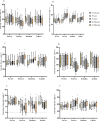The effects of different focus cues and motor learning strategies on landing mechanics in male handball players
- PMID: 40890282
- PMCID: PMC12402457
- DOI: 10.1038/s41598-025-17877-3
The effects of different focus cues and motor learning strategies on landing mechanics in male handball players
Abstract
Anterior Cruciate Ligament (ACL) injuries are a major concern in sports, especially among athletes with limited ankle dorsiflexion, impacting performance and career longevity. Targeting kinetic and kinematic risk factors of high-risk sports actions through effective strategies is crucial for injury mitigation. This study aimed to assess the impact of internal focus (IF), and external focus (EF) within linear (LP) and differential learning (DL) methods on movement quality of a single leg drop jump (SL-DJ) task training in male handball players with restricted ankle dorsiflexion. Sixty-five professional handball players (aged 20-25 years) with ankle dorsiflexion <10 degrees were randomly assigned to five groups: (1) Control group (n=13), (2) EF-LP (n=13), (3) IF with LP (IF-LP) (n=13), (4) EF-DL (n=13), and (5) IF-DL (n=13). A single 30-minute training session comprised four tasks (double-leg squats, single-leg squats, single-leg step-downs, and lateral step-downs). Pre-test, post-test, retention (24 h), and transfer (48 h, elevated task height) assessments measured joint angles (hip, knee, ankle), ground reaction forces (GRF), and moments (hip and knee) of a SL-DJ task using a 3D motion analysis system. The EF-DL demonstrated significant improvements, with increased ankle dorsiflexion angle, decreased knee valgus angle, and lower vertical GRF during SL-DJ (p < 0.001). The IF-DL showed moderate gains, while LP were less effective during retention and transfer phases. The control group did not exhibit significant improvements in any SL-DJ performed. DL combined with an EF led to significant improvements in biomechanical variables associated with ACL injury risk during SL-DJ tasks, suggesting enhanced neuromuscular efficiency and adaptability. This approach is particularly beneficial for short-term interventions and dynamic sports conditions. Future studies should expand to other sports, genders, and long-term training protocols to validate and broaden these findings.
Keywords: External focus; Internal focus; Kinematic; Kinetic; Motor learning.
© 2025. The Author(s).
Conflict of interest statement
Declarations. Competing interests: The authors declare no competing interests. Ethics approval and informed consent to participate: All experimental protocols of this study were carried out following Declaration Helsinki and were approved by the Ethics Committee of Damghan University (Approval No. IR.DU.REC.1403.011). All subjects provided written information informed consent prior to participation in the study.
Figures






Similar articles
-
Neurocognitive Challenges During Drop Vertical Jumps Increase Sensitivity to Differentiate Atypical Landing Mechanics and Jump Height in Individuals With Anterior Cruciate Ligament Reconstruction.Am J Sports Med. 2025 Jul;53(9):2154-2161. doi: 10.1177/03635465251346145. Epub 2025 Jun 7. Am J Sports Med. 2025. PMID: 40481737 Free PMC article.
-
Influence of Neuromuscular Training Interventions on Jump-Landing Biomechanics and Implications for ACL Injuries in Youth Females: A Systematic Review and Meta-analysis.Sports Med. 2025 May;55(5):1265-1292. doi: 10.1007/s40279-025-02190-w. Epub 2025 Apr 17. Sports Med. 2025. PMID: 40246764 Free PMC article.
-
What is normal? Female lower limb kinematic profiles during athletic tasks used to examine anterior cruciate ligament injury risk: a systematic review.Sports Med. 2014 Jun;44(6):815-32. doi: 10.1007/s40279-014-0168-8. Sports Med. 2014. PMID: 24682949
-
Contribution of ankle motion pattern during landing to reduce the knee-related injury risk.Comput Biol Med. 2024 Sep;180:108965. doi: 10.1016/j.compbiomed.2024.108965. Epub 2024 Jul 30. Comput Biol Med. 2024. PMID: 39084051
-
Anterior Approach Total Ankle Arthroplasty with Patient-Specific Cut Guides.JBJS Essent Surg Tech. 2025 Aug 15;15(3):e23.00027. doi: 10.2106/JBJS.ST.23.00027. eCollection 2025 Jul-Sep. JBJS Essent Surg Tech. 2025. PMID: 40821726 Free PMC article.
References
-
- Renström, P. A. Eight clinical conundrums relating to anterior cruciate ligament (ACL) injury in sport: recent evidence and a personal reflection. Br. J. Sports Med.47 (6), 367–372 (2013). - PubMed
-
- Moses, B., Orchard, J. & Orchard, J. Systematic review: annual incidence of ACL injury and surgery in various populations. Res. Sports Med.20 (3-4), 157–179 (2012). - PubMed
-
- Ardern, C. L., Taylor, N. F., Feller, J. A. & Webster, K. E. Fifty-five per cent return to competitive sport following anterior cruciate ligament reconstruction surgery: an updated systematic review and meta-analysis including aspects of physical functioning and contextual factors. Br. J. Sports Med.48 (21), 1543–1552 (2014). - PubMed
MeSH terms
LinkOut - more resources
Full Text Sources
Miscellaneous

